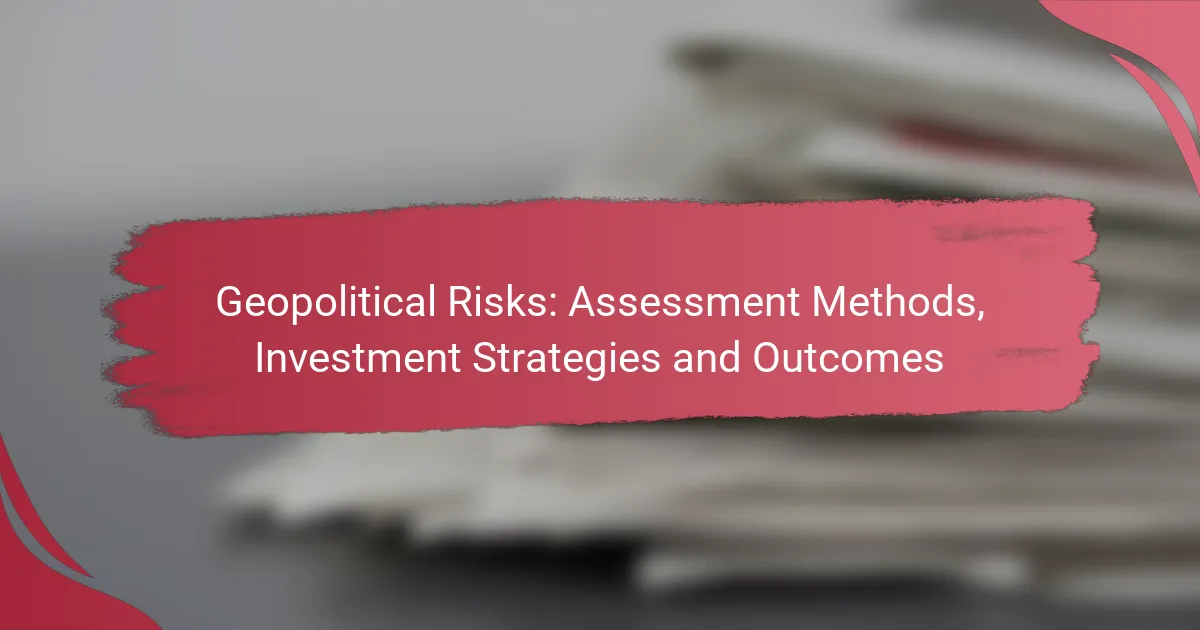Geopolitical risks pose significant challenges to global supply chains, leading to increased uncertainty, higher costs, and potential disruptions in supplier reliability. To navigate these complexities, organizations must prioritize operational resilience by diversifying suppliers, investing in technology, and developing robust contingency plans. By adopting a proactive approach, companies can better ensure continuity and adapt to the ever-changing geopolitical landscape.

How Do Geopolitical Risks Affect Global Supply Chains?
Geopolitical risks can significantly disrupt global supply chains by creating uncertainty in logistics, increasing costs, and affecting supplier reliability. Companies must navigate these challenges to maintain operational resilience and ensure smooth operations.
Disruptions in logistics
Geopolitical tensions can lead to disruptions in logistics, impacting transportation routes and delivery schedules. For example, conflicts or sanctions may close borders or restrict shipping lanes, causing delays in the movement of goods.
Companies should assess their logistics networks and consider diversifying transportation options to mitigate risks. Establishing alternative routes or using multiple carriers can help maintain supply chain continuity during crises.
Increased costs of materials
Geopolitical instability often results in increased costs for raw materials and components. Supply shortages due to conflicts or trade restrictions can drive prices up, affecting overall production expenses.
Organizations should monitor market trends and adjust their procurement strategies accordingly. Building relationships with multiple suppliers can help secure better pricing and reduce dependence on any single source.
Shifts in supplier reliability
Geopolitical risks can lead to shifts in supplier reliability, as some suppliers may become less dependable due to local instability. Companies might face challenges in receiving consistent quality or timely deliveries from affected regions.
Regularly evaluating supplier performance and having contingency plans in place can help businesses manage these risks. Establishing partnerships with suppliers in more stable regions can also enhance reliability.
Impact on inventory management
Geopolitical risks can complicate inventory management by creating uncertainty in supply availability. Companies may need to hold larger safety stocks to buffer against potential disruptions, which can tie up capital and storage resources.
Implementing just-in-case inventory strategies can provide a cushion against unexpected supply chain interruptions. However, businesses should balance this approach with the costs associated with excess inventory.
Changes in trade policies
Geopolitical events often lead to changes in trade policies, such as tariffs or import/export restrictions. These changes can directly impact supply chain costs and operational strategies.
Staying informed about trade policy developments is crucial for businesses. Engaging with trade experts or industry associations can provide insights into potential impacts and help companies adapt their supply chain strategies accordingly.

What Strategies Can Mitigate Geopolitical Risks?
To effectively mitigate geopolitical risks, organizations should adopt a multifaceted approach that includes diversifying suppliers, investing in technology, enhancing risk assessment frameworks, building local partnerships, and developing contingency plans. These strategies help ensure operational resilience and maintain supply chain continuity amid uncertainties.
Diversification of suppliers
Diversifying suppliers reduces dependency on any single source, thereby minimizing risks associated with geopolitical tensions. Companies should consider sourcing from multiple countries or regions to spread risk and enhance supply chain stability.
For instance, a business reliant on a specific region for raw materials might explore alternative suppliers in different areas. This can involve a mix of local and international partners to balance cost and reliability.
Investment in technology
Investing in technology can significantly enhance supply chain visibility and responsiveness. Tools such as advanced analytics, artificial intelligence, and blockchain can provide real-time data, enabling firms to anticipate disruptions and react swiftly.
For example, implementing a supply chain management software can help track inventory levels across various locations, allowing businesses to adjust orders proactively based on geopolitical developments.
Enhanced risk assessment frameworks
Developing robust risk assessment frameworks is crucial for identifying and analyzing potential geopolitical threats. Organizations should regularly evaluate their supply chains for vulnerabilities and assess the impact of various risk scenarios.
Utilizing tools like SWOT analysis or scenario planning can help businesses understand their risk landscape better. Regular updates to these assessments ensure that companies remain prepared for shifting geopolitical climates.
Building local partnerships
Establishing partnerships with local suppliers and businesses can strengthen supply chains against geopolitical disruptions. Local partners often have better insights into regional dynamics and can provide more agile responses to changes.
For instance, a company operating in Europe might collaborate with local firms to navigate regulatory changes or trade barriers more effectively, enhancing overall operational resilience.
Developing contingency plans
Creating comprehensive contingency plans is essential for maintaining operations during geopolitical crises. These plans should outline clear steps for responding to various scenarios, including supplier disruptions or regulatory changes.
Organizations should regularly test and update these plans, ensuring that all stakeholders are aware of their roles. A well-prepared business can pivot quickly, minimizing downtime and financial losses during unforeseen events.

What Role Does Operational Resilience Play?
Operational resilience is crucial for organizations to withstand and recover from disruptions in global supply chains. It encompasses the ability to adapt processes, maintain service continuity, and respond effectively to geopolitical risks.
Ability to adapt to changes
The ability to adapt to changes is a core component of operational resilience. Organizations must develop flexible processes that can quickly respond to unexpected events, such as political instability or trade restrictions. This may involve diversifying suppliers or adjusting logistics strategies to mitigate risks.
For instance, companies can implement scenario planning to anticipate potential disruptions and create contingency plans. This proactive approach enables businesses to pivot swiftly when faced with geopolitical challenges.
Importance of agile supply chains
Agile supply chains are essential for maintaining operational resilience in a volatile geopolitical landscape. An agile supply chain can quickly adjust to changes in demand, supply availability, and regulatory requirements. This flexibility helps organizations minimize delays and reduce costs during disruptions.
To achieve agility, companies should invest in technologies that enhance visibility and collaboration across the supply chain. For example, utilizing cloud-based platforms can facilitate real-time communication and streamline decision-making processes.
Benefits of real-time data analytics
Real-time data analytics significantly enhances operational resilience by providing timely insights into supply chain performance. Organizations can monitor key metrics, identify potential risks, and make informed decisions based on current data. This capability allows for quicker responses to geopolitical events that may impact operations.
Implementing advanced analytics tools can help businesses forecast demand fluctuations and optimize inventory levels. By leveraging data, companies can better align their resources and maintain service levels even during crises.
Case studies of resilient companies
Several companies exemplify operational resilience in the face of geopolitical risks. For example, a major automotive manufacturer diversified its supplier base across multiple countries to reduce reliance on any single region. This strategy enabled them to continue production despite trade tensions affecting specific markets.
Another example is a global electronics firm that invested in digital supply chain technologies, allowing them to quickly adapt to changing regulations and consumer demands. Their ability to leverage data analytics not only improved efficiency but also enhanced their overall resilience against disruptions.

How Can Companies Assess Their Vulnerability?
Companies can assess their vulnerability to geopolitical risks by identifying potential threats and evaluating their impact on supply chains. This process involves a combination of analytical tools and strategic planning to enhance operational resilience.
Risk assessment tools
Risk assessment tools help companies quantify and prioritize vulnerabilities in their supply chains. Common tools include SWOT analysis, which evaluates strengths, weaknesses, opportunities, and threats, and risk matrices that categorize risks based on likelihood and impact. Utilizing these tools allows organizations to pinpoint critical areas that require immediate attention.
Companies should consider integrating software solutions that provide real-time data on geopolitical events, enabling proactive responses. For example, platforms like Resilience360 offer insights into supply chain disruptions caused by political instability.
Scenario planning techniques
Scenario planning techniques involve creating detailed narratives about potential future events and their implications for the business. This method encourages companies to envision various geopolitical scenarios, such as trade wars or regulatory changes, and develop corresponding response strategies. By preparing for multiple outcomes, organizations can enhance their adaptability.
Implementing regular scenario planning workshops can foster a culture of resilience within the organization. Companies may also benefit from collaborating with industry peers to share insights and strategies for navigating uncertain environments.
Benchmarking against industry standards
Benchmarking against industry standards allows companies to evaluate their vulnerability relative to peers. This process involves comparing operational practices, risk management strategies, and resilience metrics with those of leading organizations in the same sector. By identifying gaps, companies can prioritize improvements to their supply chain strategies.
Industry reports and surveys, such as those from the World Economic Forum, provide valuable benchmarks for assessing performance. Companies should regularly review these benchmarks to stay aligned with best practices and adapt to evolving geopolitical landscapes.

What Are the Key Indicators of Geopolitical Risks?
Key indicators of geopolitical risks include factors that affect political stability and economic conditions. Monitoring these indicators helps businesses assess potential disruptions in global supply chains and enhance operational resilience.
Political stability metrics
Political stability metrics evaluate the likelihood of government instability or violence, which can disrupt supply chains. Key metrics include government effectiveness, regulatory quality, and the prevalence of violence or terrorism. Tools like the Worldwide Governance Indicators (WGI) can provide insights into these aspects.
Businesses should consider the stability of the regions where they operate or source materials. For instance, a country experiencing political unrest may pose higher risks for supply chain disruptions. Regularly reviewing political risk assessments can help companies make informed decisions about their operations.
Economic indicators
Economic indicators reflect the overall health of a country’s economy and its potential impact on geopolitical risks. Key indicators include GDP growth rates, inflation rates, and unemployment figures. A declining GDP or rising inflation can signal instability, affecting supply chain reliability.
Companies should track economic trends in their key markets. For example, if inflation exceeds 5% in a region, it may lead to increased costs and supply chain challenges. Establishing a framework for monitoring these indicators can enhance a company’s ability to respond proactively to potential disruptions.



